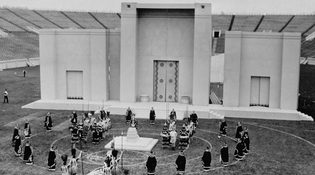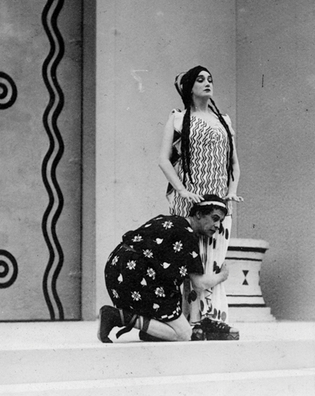 loading
loading
Old YaleIphigenia at the Yale BowlA hundred years ago, an experiment in acoustics led to high drama. Judith Ann Schiff is chief research archivist at the Yale University Library.  Manuscripts and ArchivesSeveral months after the Yale Bowl was built, a British theater company performed Iphigenia in Tauris by Euripides there, in English translation. The set included a large, portable temple (above), and the title character (below) was played by the actress Lillah McCarthy. View full image Manuscripts and ArchivesView full imageIn the spring of 1915, a massive temple was erected on the field of the Yale Bowl. It was 160 feet long, stood 30 feet tall at each end, and rose to 40 feet high in the middle. It was not, however, permanent. The temple was part of a touring English production of Iphigenia in Tauris by Euripides—“Euripides for the Elis,” the New York Times headline called it on May 9. That was six days before opening night—or rather opening afternoon, since the performances were scheduled “according to the ancient custom,” as the Times put it. Some 10,000 people attended the first performance (though the Times estimated 15,000). Iphigenia came to the Yale Bowl largely because of William Lyon “Billy” Phelps ’87, ’91PhD, one of the university’s most popular English literature professors. Phelps was also the founder of the Pundits, and it was he who helped Alexander Smith Cochran ’96 to found the Elizabethan Club. As Phelps recalled in his Autobiography, the influential English producer Harley Granville-Barker “came to New York in February [1915] to produce plays and I had many good talks with him; an amazingly interesting personality.” On March 3, Phelps wrote, Granville-Barker visited Yale to give a lecture on “The Drama.” The Bowl had been finished only the previous fall, and having in mind, perhaps, that it was modeled after an ancient amphitheater in Pompeii, Phelps and Granville-Barker “went out to the Yale Bowl to test its acoustic properties. It was a bitter cold day with a howling wind; and although the Bowl had been built for spectacles and not for auditions, to our astonishment the acoustics were so perfect that spoken words were distinctly heard. As a result of this test, Granville-Barker decided to produce a Greek play here in the spring.” The Bowl production was managed by the Yale Dramat and the incidental music composed by Yale music professor David Stanley Smith ’00, ’03BMus, longtime conductor of the New Haven Symphony. The prominent New York composer and conductor Elliot Schenck led the 50-piece orchestra. Lillah McCarthy, a successful actress and the wife of Granville-Barker, played the title role. The actor best known today, however, played a herdsman: he was Claude Rains, who years later appeared as Captain Louis Renault in the movie Casablanca. Most press reviews praised the play, the performances, and the production. But the weak spot appears to have been the costumes. Francis Hackett, in the New Republic, wrote that the costume designer “had known so little embarrassment that he turned the costumes of Tauris into uproarious farce.” The audience, especially the undergraduates, noticed and reacted—loudly: the New York Sun headline began, “Irreverent Yale Freshmen Laugh.” (The writer opined, “These young students who laughed had never seen the famous Ballets Russes or the productions of Reinhardt and Gordon Craig, and hence knew nothing of the pictorial tendencies of the modern stage.”) The Yale performances were only the production’s premiere. Iphigenia traveled over the following month to Harvard, the City University of New York, a country club on Long Island, the University of Pennsylvania, and Princeton. Wherever the company went, the temple traveled with them: the entire stage set was dismantled, transported, and reassembled for each new venue.
|
|
2 comments
-

Dr. Richard C. Beacham, 1:53pm June 12 2015 |  Flag as inappropriate
Flag as inappropriate
-

Mark Branch, 4:33pm June 12 2015 |  Flag as inappropriate
Flag as inappropriate
The comment period has expired.It was a pleasure reading the piece "Iphigenia at the Yale Bowl" by Library archivist Judith Ann Schiff. It did however, have the ring of familiarity.
Your own archives would reveal that some years ago I researched and wrote a rather similar, somewhat longer piece: "Tragedy in the Bowl! Granville Barker's Iphigenia at Yale, 1915", which was published by the Alumni Magazine, in June, 1984, 48-51. In preparing it (while on sabbatical leave and teaching a college seminar course at Yale as a visiting professor), I discovered in the archives of the Drama School Library an impressive cache of photos both of the Iphigenia (taken on a brownie camera by an undergraduate) as well as of Baker's production of The Trojan Women, which toured with it. Baker had been the first to stage ancient Greek theatre (very successfully) in the UK commercial theatre, and had been encouraged by the British government to bring his productions to the United States as a public relations exercise in support of the British war effort.
Obviously the subject is an intriguing one! In fact, it figured a few years ago in a play about Baker, "Farewell to the Theatre", by Richard Nelson, produced here in the UK at the Hampstead Theatre.
Richard Beacham '68; '73 DFA
Sorry we missed your earlier article, Mr. Beacham. I wish we could link to it here, but our online archives only go back to the 1990s.